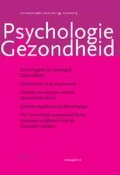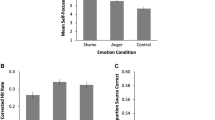Degrading negative and positive memories
Earlier studies have shown that horizontal eye movements (EM) during retrieval of a negative memory reduce its vividness and emotionality. This may be due to both tasks competing for working memory (WM) resources. This study examined whether playing the computer game “Tetris” also blurs memory. Participants recalled negative and positive memories in three conditions: recall only, recall with concurrent EM, and recall with playing Tetris. Before and after these conditions, vividness, emotionality, and physiological startle responses during recall were measured. A reaction time task showed that EM and Tetris both draw on WM, compared to no dual-task. Compared to recall only, EMand Tetris both decreased reported emotionality and startle responses. The effects of EM and Tetris did not differ, even though the tasks differed in the degree of taxing WM. This suggests that taxingWMand its effects on emotional memories may not be linearly related. Potential clinical implications are discussed.



Similar content being viewed by others
Notes
De gemiddelde score was: 14.98 (SD=18.65) voor ‘alleen ophalen’, 15.87 (SD=19, 21) voor oogbewegingen en 16.50 (18.80) voor Tetris.
Literatuur
Andrade, J., Kavanagh, D., & Baddeley, A. (1997). Eye-movements and visual imagery: A working memory approach to the treatment of post-traumatic stress disorder. British Journal of Clinical Psychology, 36, 209–223.
Baddeley, A.D. (1998). Humanmemory: Theory and practice. Needham Heights, MA: Allyn & Bacon.
Barrowcliff, A.L., Gray, N.S., Freeman, T.C.A., & MacCulloch, M.J. (2004). Eye movements reduce the vividness, emotional valence and electrodermal arousal associated with negative autobiographical memories. Journal of Forensic Psychiatry and Psychology, 15, 325–345.
Bisson, J.I., Ehlers, A., Matthews, R., Pilling, S., Richards, D., & Turner, S. (2007). Psychological treatments for chronic posttraumatic stress disorder: Systematic review and meta-analysis. British Journal of Psychiatry, 190, 97–104.
Blumenthal, T.D., Cuthbert, B.N., Filion, D.L., Hackley, S., Lipp, O.V., & Van Boxtel, A. (2005). Committee report: Guidelines for human startle eyeblink electromyographic studies. Psychophysiology, 42, 1–15.
Brewin, C.R., Gregory, J.D., Lipton, M., & Burgess, N. (2010). Intrusive images in psychological disorders: Characteristics, neural mechanisms, and treatment implications. Psychological Review, 117, 210–232.
De Jongh, A. & Ten Broeke, E. (2003). Handboek EMDR: een geprotocolleerde behandelmethode voor de gevolgen van psychotrauma. Amsterdam: Harcourt publishers.
Engelhard, I.M., & van den Hout, M.A. (2010). Oogbewegingen verminderen de helderheid en emotionaliteit van “flashforwards”. De Psycholoog, 45, 10–18.
Engelhard, I.M., van den Hout, M.A., Janssen, W.C., & van der Beek, J. (2010a). Eye movements reduce vividness and emotionality of images about feared future events. Behaviour Research and Therapy, 48, 442–447.
Engelhard, I.M., van den Hout, M.A., & Smeets, M.A.M. (2010b). Mate van werkgeheugen belasting tijdens ‘recall’ en vervagen van herinneringen. Gedragstherapie, 43, 265–278.
Grillon, C., & Baas, J. (2003). A review of themodulation of the startle reflex by affective states and it application in psychiatry. Clinical Neurophysiology, 114, 1557–1579.
Gunter, R.W., & Bodner, G.E. (2008). How eyemovements affect unpleasant memories: Support for a working-memory account. Behaviour Research and Therapy, 46, 913–931.
Hackman, A., & Holmes, E. (2004). Reflecting on imagery: A clinical perspective and overview of the special issue of Memory on mental imagery and memory in psychopathology. Memory, 12, 389–402.
Holmes, E.A. & Bourne, C. (2008). Inducing and modulating intrusive emotional memories: A review of the trauma film paradigm. Acta Psychologica, 127, 553–566.
Holmes, E.A., James, E.L., Coode-Bate, T., & Deeprose, C. (2009). Can playing the computer game “Tetris” reduce the build-up of flashbacks or trauma? A proposal from Cognitive Science. PLoS ONE, 4, 1–6.
Hornsveld, H.K., Houtveen, J.H., Vroomen, M., Kapteijn, I., Aalbers, D., & van den Hout, M.A. (2010). Negative effects of eye movements in Resource Development and Installation (RDI). Ter publicatie aangeboden.
Kemps, E., & Tiggemann, M. (2007a). Reducing the vividness and emotional impact of distressing autobiographical memories: The importance of modality-specific interference. Memory, 15, 412–422.
Kemps, E., & Tiggemann, M. (2007b). Modality-specific imagery reduces cravings for food: an application of the elaborated intrusion theory of desire to food craving. Journal of Experimental Psychology: Applied, 13, 95–104.
Lee, C.W., & Cuijpers, P. (2010). Ameta-analysis of the contribution of eye movements in processing emotional memories. Ter publicatie aangeboden.
May, J., Andrade, J., Panabokke, N., & Kavanagh, D. (2010). Visuospatial tasks suppress craving for cigarettes. Behaviour Research and Therapy.48, 476–485.
Maxfield, L., Melnyk, W.T., & Gordon Hayman, C.A. (2008). A working memory explanation for the effects of eye movements in EMDR. Journal of EMDR Practice and Research, 2, 247–261.
Merckelbach, H., Hogervorst, E., Kampman, M., & de Jongh, A. (1994). Eye-movement desenisitization heeft geen effect of emotionele reactiviteit van ‘normale’ proefpersonen. Gedragstherapie, 27, 33–49.
Miller, M.W., Patrick, C.J., & Levenston, G.K. (2002). Affective imagery and the startle response: Probing mechanisms of modulation during pleasant scenes, personal experiences, and discrete negative emotions. Psychophysiology, 39, 519–529.
Muris, P. & Merckelbach, H. (1999). Traumatic memories, eye movements, phobia, and panic: A critical note on the proliferation of EMDR. Journal of Anxiety Disorders, 13, 209–223.
Shapiro, F. (2001). Eyemovement desensitization and reprocessing: Basic principles, protocols, and procedures. New York: Guilford Press.
Ten Broeke, E., De Jongh, A. & Oppenheim, H. (2008). Praktijkboek EMDR: casusconceptualisatie en specifieke patiëntengroepen. Amsterdam: Harcourt publishers.
Tetris® & © TETRIS game and tetris.com, zone.tetris.com © 2007 Tetris Holding, LLC Game Design by Alexey Pajitnov. Tetris game is een ‘registered trademark’ van Tetris Holding, LLC en was verkregen van Blue Planet Software (Honolulu, HI).
Van den Hout, M.A., Engelhard, I.M., Beetsma, D, Slofstra, C, Hornsveld, H., & Houtveen, J. (2010a). Commonalities in EMDR and MBCT: Eye movements and attentional breathing tax working memory and reduce vividness of aversive ideation. Ter publicatie aangeboden.
Van den Hout, M.A., Engelhard, I.M., Smeets, M.A.M., Hornsveld, H., Hoogeveen, E., de Heer, E. et al. (2010b). Counting during recall: taxing of workingmemory and reduced vividness and emotionality of negativememories. Applied Cognitive Psychology, 24, 303–311.
Van den Hout, M., Muris, P., Salemink, E., & Kindt, M. (2001). Autobiographical memories become less vivid and emotional after eye movements. British Journal of Clinical Psychology, 40, 121–130.
Author information
Authors and Affiliations
Additional information
Dit is een bewerking van een Engelstalig artikel: Engelhard, I.M., van Uijen, S.L., & van den Hout, M.A. (2010). The impact of taxing workingmemory on negative and positive memories. European Journal of Psychotraumatology, 1: 5623 - DOI: 10.3402/ejpt.v1i0.5623, met toestemming van de uitgever en overeenkomstig de voorwaarden van de licentieovereenkomst: http://creativecommons.org/licenses/by-nc/3.0/
Rights and permissions
About this article
Cite this article
Engelhard, I., van den Hout, M. & van Uijen, S. Het vervagen van negatieve en positieve herinneringen. PSYCHOL. GEZONDH. 39, 61–69 (2011). https://doi.org/10.1007/s12483-011-0017-5
Published:
Issue Date:
DOI: https://doi.org/10.1007/s12483-011-0017-5




